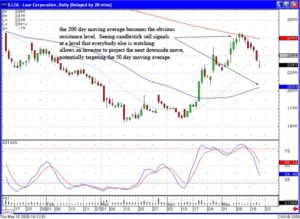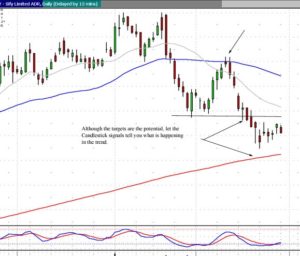How do most people attempt to make money investing in stock? Buying a recommendation from somebody else and “hoping” that they make money. Unfortunately, to make money investing in stock requires a much more systematic program. Candlestick analysis provides that format. Japanese Rice traders, over the past few centuries, learned to identify patterns on charts that revealed a high probability of a reversal occurring. To make money investing in stock, an investor requires a trading plan that has validity.
Most investors try to make money investing in stock by using whatever popular investment program seems to be working at the time. The downfall of this approach is that when a program or trading method does not work, instead of trying to understand why, most investors move on to find the next trading program that seems to be working.
Utilizing candlestick signals, while trying to make money investing in stock is one important common sense aspect. Investor psychology is built into the candlestick signals. Understanding the investor psychology allows an investor to fine-tune a high probability trading method. Being that candlestick signals is the oldest and most proven trading method in the world, the assumption can be that it works. If it doesn’t seem to be working for you, then going back and analyzing what was wrong with your interpretation leads to better education of the trading program. This constant education builds knowledge that can be utilized for any trading market in the future.
Where do candlestick signals work most effectively? Candlestick signals work effectively on their own. However, the more confirming indicators an investor can apply to the analysis of a trend, the higher the probability of being in a correct trade. A candlestick buy signal, in an oversold condition, indicates a high probability that an uptrend is going to start. A candlestick buy signal in an oversold condition and forming at a major support level such as a moving average or a trend line gives that signal that much more credibility. Conversely, a candlestick sell signal in overbought condition forming right at a major moving average is a strong indication that a downtrend is going to occur. This is not rocket science! This is having the ability to analyze, through candlestick signals, what investor sentiment is doing at important support or resistance levels.
As illustrated in the Lear Corp. chart, Doji’s forming at the 200 day moving average reveal that the uptrend is becoming indecisive at a major resistance level. If a trend fails a major resistance area such as a moving average, what becomes the next target? The next moving average below. Notice that a short position established as weakness appeared just below the 200 day moving average has already produced a relatively good profit. However, analyzing the stochastics and not seeing any candlestick buy signals should create the evaluation of the downtrend still in place, the 50 day moving average being a logical target.

LEA
The same scenario is illustrated in the SIFY chart. The Doji shows indecision at the 50 day moving average. When a moving average is failed, two levels became the obvious targets. The recent low at approximately the $11 area was the first target. If that level was breached, 200 day moving average becomes the next target. This is a common chart pattern.

SIFY
This pattern is named the Blue Ice Failure by David Elliott of WallStreetteachers.com.
Speak Your Mind